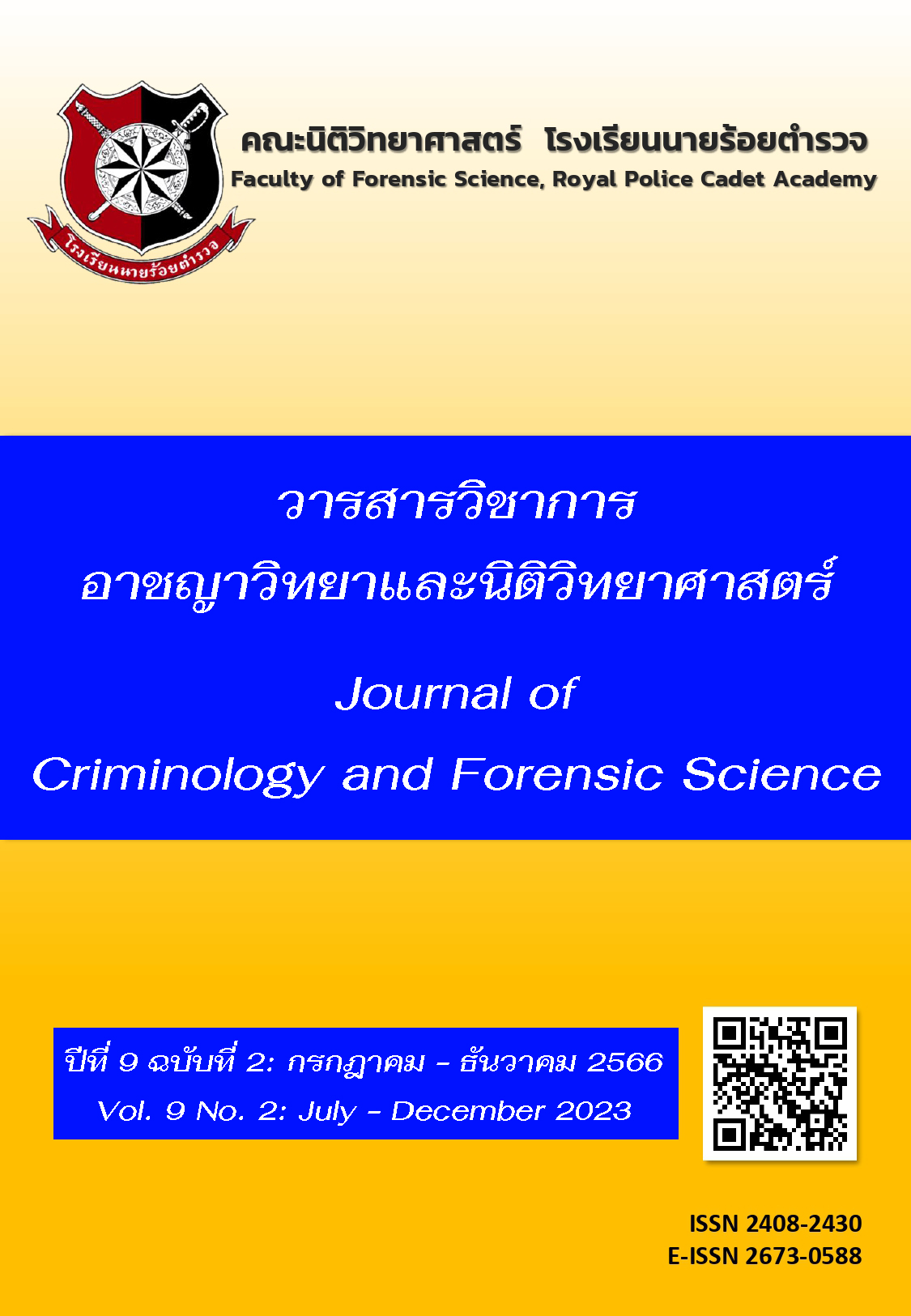การจัดการความรู้สำหรับการพัฒนาเครือข่ายเยาวชนเพื่อป้องกัน การกระทำความผิดและตกเป็นเหยื่ออาชญากรรมด้วยกระบวนการสื่อสังคมออนไลน์
Main Article Content
บทคัดย่อ
บทความวิจัยนี้มีวัตถุประสงค์เพื่อจัดการความรู้ในการนำไปพัฒนาเครือข่ายเยาวชน กลุ่มเป้าหมายอยู่ในพื้นที่ตำรวจภูธรภาค 7 ได้แก่ ตำรวจมวลชนสัมพันธ์ เยาวชน บุคลากรภาครัฐ ภาคเอกชน และภาคประชาชน การวิจัยครั้งนี้ใช้ระเบียบวิธีวิจัยผสมผสานด้วยการวิเคราะห์เอกสารการสัมภาษณ์เชิงลึก การสนทนากลุ่ม และการตอบแบบสอบถาม ผลการศึกษาพบว่า แนวทางการสร้างและพัฒนาเครือข่ายเยาวชนที่ดี ประกอบด้วย 4 ขั้นตอน ได้แก่ 1) ขั้นเตรียมการ 2) ขั้นรับสมัครและคัดเลือกแกนนำเครือข่าย 3) ขั้นฝึกอบรม และ 4) ขั้นขยายเครือข่ายและสร้างความยั่งยืน การบูรณาการความร่วมมือระหว่างหน่วยงานบังคับใช้กฎหมายกับบุคลากรหลากหลายหน่วยงานที่ดูแลเยาวชน อาทิ ผู้บริหารสถานศึกษา ครูฝ่ายกิจกรรมนักเรียน รวมถึงตัวแทนเยาวชนที่เป็นแกนนำเครือข่ายได้ร่วมขับเคลื่อนกิจกรรมที่ให้สมาชิกมีส่วนร่วมผ่านสื่อสังคมออนไลน์มุ่งเน้นไปที่การสร้างความตระหนักรู้เกี่ยวกับภัยอาชญากรรม ภายหลังการถ่ายทอดความรู้ผ่านคู่มือและการระดมความคิดเห็น พบว่า กลุ่มเป้าหมายมีระดับความรู้ความเข้าใจในภาพรวมเป็นอย่างดี และมีความเข้าใจการในการร่วมขับเคลื่อนกิจกรรมเครือข่ายผ่านสื่อสังคมออนไลน์ที่เพิ่มขึ้น นอกจากนี้สมาชิกเครือข่ายยังสามารถสร้าง และใช้งานสื่อสังคมออนไลน์ได้อย่างสร้างสรรค์ ยิ่งไปกว่านั้นสมาชิกเครือข่ายยังมีความปรารถนาที่จะต่อยอดผลสัมฤทธิ์ของกิจกรรมในเครือข่ายด้วยการประชาสัมพันธ์ภายในหน่วยงาน และในพื้นที่ของตนเพื่อสร้างความต่อเนื่องอีกด้วย
Article Details

อนุญาตภายใต้เงื่อนไข Creative Commons Attribution-NonCommercial-NoDerivatives 4.0 International License.
เนื้อหาและข้อมูลในบทความที่ลงตีพิมพ์ใน วารสารวิชาการอาชญาวิทยาและนิติวิทยาศาสตร์ โรงเรียนนายร้อยตำรวจ ถิอว่าเป็นข้อคิดเห็นและความรั้บผิดชอบของผู้เขียนบทความโดยตรงซึ่งกองบรรณาธิการวารสาร ไม่จำเป็นต้องเห็นด้วยหรือรับผิดชอบใดๆ
บทความ ข้อมูล เนื้อหา รูปภาพ ฯลฯ ที่ได้รับการตีพิมพ์ใน วารสารวิชาการอาชญาวิทยาและนิติวิทยาศาสตร์ ถือว่าเป็นลิขสิทธิ์ของวารสาร วารสารวิชาการอาชญาวิทยาและนิติวิทยาศาสตร์ หากบุคคลหรือหน่วยงานใดต้องการนำทั้งหมดหรือส่วนหนึ่งส่วนใดไปเผยแพร่ต่อหรือเพื่อกระทำการใดๆ จะต้องได้รับอนุญาตเป็นลายลักษณ์อักษรจาก วารสารวิชาการอาชญาวิทยาและนิติวิทยาศาสตร์ ก่อนเท่านั้น
เอกสารอ้างอิง
Bunyakit, B., Prasopsukchokchai, N., Phonchanoknat, D. and Kanluan, P. (2004). Knowledge management from theory to practice. Bangkok: Jirawat Express Company Limited. (in Thai).
Chailaisathaporn, S., Prasertsin, A. and Techataweewan, W. (2017). Experiences and guidelines of coping in young Thai victims of cyberbullying. Journal of Curriculum Research and Development, 7(2), 215-234. (in Thai).
Demarest, M. (1997). Understanding knowledge management. Journal of Long range planning, 30(3), 374-384.
Electronic Transactions Development Agency. (2021). ETDA press release reveals that COVID-19 is a noticeable cause - Gen Z used the internet the most in the first year, beating Gen Y, the 6-time champion. Retrieved March 6, 2022.
from https://www.etda.or.th/th/prnews/ETDA-released-IUB-2021.aspx. (in Thai).
Hengtrakul, K. (2012). Adolescents: Young criminals and crime victims. Journal of Thai Justic System, 5(2), 15-21. (in Thai).
Information Technology Center Department of Juvenile Observation and Protection. (2018). Statistics of historical cases between the years 2010 - 2015. Retrieved March 6, 2022. from http://www.djop.go.th/stat/statbetween2008-2011. (in Thai).
Institute for Population and Social Research Mahidol University. (2020). Two decades of Thai education reform Failure and success. Nakhon Pathom: Institute for Population and Social Research. (in Thai).
Limprasert, S., Rujiprak, V., and Thipphayamongkoludom, Y. (2020). Victimization of sexual violence by children and youth. Journal of Social Science and Buddhistic Anthropology, 5(9), 230-246. (in Thai).
Phothisuwan, S.(2020). Research and development of youth networks to prevent wrongdoing and becoming victims of crime through social media processes. Academic Journal of the Faculty of Humanities and Social Sciences, 11(1), 1-14. (in Thai).
Thitiudomphatana, R. (2014). Victimization of Juvenile Trafficking: A Case Study of Sexual Exploitation. Kasalongkham Research Journal, 149-164. (in Thai).


